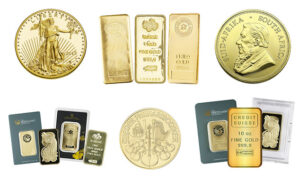There are lots of reasons to buy silver—it’s a real asset, the coins are beautiful, it will likely outperform gold (and probably by a long shot), and it’s more affordable. But that affordability comes with a catch.
Once you start to accumulate, you quickly realize that silver requires a lot more storage space than gold. It’s relatively easy to hide some gold coins in a sock drawer or cookie jar, but those hiding places are impractical for the same dollar amount of silver.
So how do we store our silver bullion both efficiently and safely? And should it be stored at home anyway? This article has some potential solutions for those investors that are stacking silver…
Storing Silver Bullion at Home
Everyone should keep some silver (and gold) in a place that is easily and immediately accessible. One advantage bullion offers is its high liquidity in a period of crisis—no worries about bank closures, lack of access to funds, or internet problems.
So, if you have some bullion close by, you have the ability to fight through a crisis. On the other hand, if your silver is two days away or time-consuming to get to, its use as an emergency asset has diminished.
As I pointed out in my book, Guide to Investing in Gold and Silver, “I believe everyone should have gold and silver in his or her own private possession, where you can lay your hands on it, because they are one of the few financial assets that can be completely private and not part of the financial system.”
This doesn’t mean you should keep it inside your house. It means you want some of it readily accessible in an emergency, whether that emergency be a personal one or on a national scale. Here are the three factors to consider when storing silver at home:
1. Space and Weight Requirements
At today’s prices, dollar for dollar, you get roughly 70 times more ounces of silver than gold. On top of that, most silver is a lot less dense than gold. In fact, pure silver is 84% larger in volume than pure gold. Add those two facts together and it means that silver takes up as much as 128 times more space than gold for the same dollar value!
Here’s a couple practical examples of the difference: A one-ounce American Gold Eagle coin is about the same size as a U.S. $0.50 piece, and can fit in your pants pocket along with your other change, keys, and cell phone. But, a one-ounce American Silver Eagle coin is significantly larger—your pants pocket would have to hold 70 of them and they’d weigh almost 5 pounds. The same is true with larger amounts: you can hold $50,000 worth of gold in one hand—but it would take 10 large shoe boxes to hold the same dollar amount of silver!
The difference in weight is also significant: $50,000 worth of gold weighs about 2.6 pounds—but the same value of silver would weigh about 189 pounds!
In other words, whether you’re dealing with coins or bars, you’ll need a lot more space to store silver bullion. It’s also more difficult, expensive, and cumbersome to transport.
The most popular form of silver is the one-ounce American Eagle coin. And the most popular order size is what’s called a monster box—a case of 500, 1-ounce coins, separated into 25 tubes of 20 coins each. A monster box measures 15” X 8.5” X 4.5”. Here’s how big that is:

A monster box of Canadian Silver Maple Leaf coins varies slightly (instead of 25 tubes of 20 coins, it contains 20 tubes of 25 coins), and measures: 10” X 8” X 5”.
If you’re stacking bars, the most popular size is the 100-ounce silver bar. The dimensions are roughly the same for most bars—here’s what one measures from the Royal Canadian Mint: 7.2” X 3.2” X 0.8”. It’s roughly the size of three or four large Hershey bars stacked on top of each other.
2. Personal Comfort Level
How much bullion are you and your confidant comfortable keeping in your home?
Your two biggest risks are theft and natural disaster. Here’s a checklist of questions to ask yourself about storing bullion at home…
- Does more than one person know you own precious metals? If so, who might they tell, even if it’s innocent? Do your kids know? Depending on their age and maturity, could they talk?
- Is your income or assets high enough to make you a natural target? Do you work in the public eye? Have you talked positively about gold and silver, including on social media?
- Do you have an alarm monitoring system? This may not prevent a theft but would ideally give you an immediate police response.
- Are your hiding spots clever enough? To answer this, “think like a thief;” how long before a persistent and desperate robber finds your bullion?
- If you use a safe, is it fireproof? What level of protection does your safe have against other natural disasters?
- Is your safe small enough that a thief could walk out with it? If it’s secured to the floor in some way, how would you respond if a thief found it and demanded you open it?
- Do you have some decoy bullion or valuables?
- Is your bullion hidden so well that you couldn’t find it if you forgot where it was? Or your heirs would have a hard time finding it?
- Keep in mind that insuring your home-stored bullion is costly, and most home insurance plans may not cover the full value if silver rises a lot in price. Further, it breaks the golden rule of telling too many people what you have—insurance agents, office staff, corporate offices, appraisers and their staff—and don’t forget that they might tell someone! Insuring your home bullion is a personal decision, but we prefer the privacy.
Indoor storage is practical for small quantities. You can probably think of dozens of places in your home where no one would think to look.
The trick is to hide your bullion in such a way that it isn’t too complicated for you or your heirs to find, but is hard enough for a thief to find. Here’s a few tips on hiding locations (note that some of these come from customer input and are not necessarily what we would recommend)…
3. Hiding Tips
Nothing Obvious: No fake cookie jars, rocks, or carved out books. They’re too common. If you’ve seen your hiding spot in a movie, find another one.
Three Layers Deep: A good rule of thumb is to store your silver three layers deep, since most burglars look for things they can grab and go. For example, a floor safe, covered by floor boards, with carpet and a china cabinet over it.
Safes: A safe is certainly much better than behind some books, but keep in mind that no safe is 100% secure. A safe buys you time, nothing more. If you use a key safe, hide the key separately from the safe. If you use a combination lock, don’t assume you’re immune from robbery—a friend of my father’s had a gun pointed to his wife’s head while they asked him for the combination to his safe.
Another consideration is the weight of the safe. One that weighs, say, 100 pounds, could be moved (i.e., stolen) by one or two burglars with some basic tools like a dolly or straps. A 300-400 pound safe removes theft risk from a single person. Heavier than 500 pounds and you’re immune from most home burglaries, unless there’s a group of them and they have a heavy duty vehicle. Of course, the heavier the safe the more likely you’ll need it delivered and installed, which then tips your hand that you’ve likely got a lot of valuables in the house.
Midnight Gardening: A couple pointers if you bury your silver (the term “midnight gardening” comes from people who bury their gold at night so the digging won’t be noticed)…
- For your silver storage box, try a container that is both airtight and waterproof (don’t use a coffee can, since the color on the metal can bleed). If you’re burying a lot of coins separate small piles of them into plastic baggies to avoid scratching.
- Consider how easy or too difficult it is to find. If it’s too easy, a thief could find it. But it it’s too difficult your heirs may have a hard time locating it. Find a place, on property you own, that you’ll always remember but isn’t obvious if someone learns you’ve buried something valuable. It’s probably not a good idea to leave complicated instructions; if you use a “treasure map,” give part of the instructions to one person you trust and the other part to a different confidant.
- Metal detectors can detect up to a depth of about 4 feet.
A related option might be to build a safe in the floor of a storage shed. The advantage here is that you can access your bullion without being seen, day or night.
Home Security Systems: The more metal you have at home, the more you need to consider a security system that comes with both cameras and monitoring. Or consider a nanny cam; they’re not expensive.
Firearms: If you store metals at home and have a safe, and IF you feel comfortable having a gun in the house, a firearm might be a way to defend yourself in the event of a break-in while you’re home. We don’t necessarily recommend purchasing a firearm, however, as there a number of considerations to keeping a weapon in the house.
Decoys: Consider keeping two safes, one of which is cheap with a few items in it so the thief thinks he got your stash, and then the real one well hidden in a different part of the house with your silver and other valuables.
Diversify: Use more than one hiding spot. But don’t use so many that you forget where they all are!
You can get more ideas here.
What About Tarnishing?
The great thing about gold is that in its pure form it does not rust or tarnish. It doesn’t react with oxygen very easily—that’s why gold from 2,000 years ago still looks like gold. This includes gold jewelry—if you see a piece of jewelry that has tarnish on it, that portion is not gold, those are other metals. (You can get some great gold jewelry tips here.)
Still, it’s best to store gold in a cool dry place, and as a “soft” metal needs to be handled with care (no playing Frisbee with your coins!).
Silver, on the other hand, does tarnish over time, and also scratches easily. So some care is needed. The good news is, that care is relatively easy and inexpensive…
- Cool and dry. Store your silver away from heat and humidity—no wet basements or humid attics. Also, avoid newspapers and anything else that has ink on it, and rubber bands or items that can break down over time and stick to the silver.
- Use an enclosed container that will minimize its exposure to air, and one that won’t scratch your coins or bars.
- Storing silver bullion (and jewelry and silverware) in a soft cloth can slow down tarnishing.
- If your silver does eventually tarnish, use a cleaner specifically designed for silver.
Should We Use a Bank Safe Deposit Box?
Easy, simple, and relatively inexpensive—those are the advantages to using a safe deposit box at your local bank. But consider the drawbacks…
- Your access is restricted. You can only get to the bullion during regular banking hours. No evening, weekend or holiday access. In fact, during 9/11, some banks were closed for a period of time.
- No insurance against robbery or disaster. Think about the customers whose safe deposit boxes were washed away with the tsunami in Japan in 2011.
- Lack of privacy. If the government or an aggressive attorney comes after you, they’ll thank you for the generous clue you provided them of where some of your assets are stored.
- Silver takes up so much space that you’d likely be forced to pay for a larger box. And it might not be an option at all… a monster box of silver is too big for most any safe bank deposit box.
Remember, one reason we own physical bullion is to protect against the banking system. If you go this route, be aware of the risks and only place a small portion of your metal there.
What About a Professional, Third Party Vaulting Service?
Once your stash starts to grow, I recommend you consider private storage. Not only do you run out of space at home but your risk grows as you accumulate more and more metal. You don’t want to be wiped out if something happened to your stash at home.
The keys to professional storage are that your metal be held: 1. Outside the banking system. 2. Fully segregated or allocated in your name, and fully insured. 3. Easy online access.
I’m proud to say that GoldSilver’s program meets all these criteria and more. These are the same vaults Mike and I use. Highly liquid, 100% insured, and can be done online instantaneously. Again, use this option once you have a reasonable amount of bullion stored at or near home, but have reached a point where it would be wise to divvy it up.
The Ideal Solution to Home Storage
The message here is that no storage location is 100% secure (though professional storage is 100% insured). Therefore, the best way for storing silver is to diversify your locations. The more you accumulate, the more you should utilize several methods for storing silver.
Don’t put yourself in a position where you’re left silver-less if something happens to your stash. Silver bullion is a tangible asset that serves as inexpensive insurance against all types of crisis. We’re convinced you’re making a wise decision by owning it. But review your storage methods to determine the best ways to hold on to your silver.








